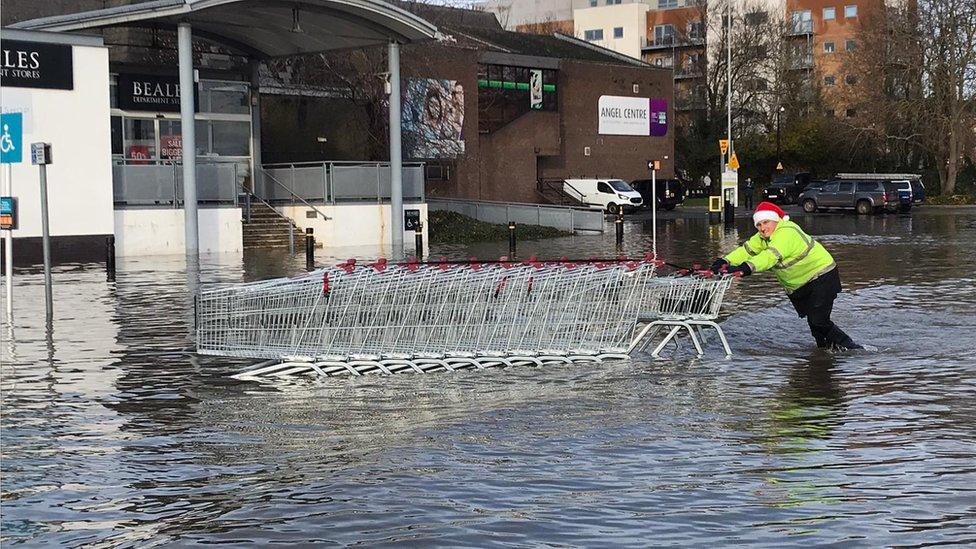Natural solutions boosted to help prevent floods
- Published
- comments

Last winter saw extensive flooding across the country
A new approach to combating floods in England, backing natural solutions with government cash, has been unveiled.
It includes funding for schemes such as creating sustainable drainage systems - and building hollows in the ground to catch flood water in heavy rain, before storing it to tackle summer droughts.
Insurers have also been asked to pay to improve flood-hit homes so they are more resilient.
The policy allowing building on plains liable to flood will be reviewed.
And £200 million of the floods budget will be earmarked for measures including natural flood prevention to capture water on farmers' fields during heavy rainfall.
Critics say the schemes do not go far enough at a time of climate change.
Flooding was forced up the priority list after Prime Minister Boris Johnson was accused by flood victims of failing to take their plight seriously.
The government says the measures in the new plan are the most comprehensive in a decade, including the £5.2bn for flooding announced in the Budget four months ago.
It says the cash will help protect a third of a million properties in England up to 2027.
There will be money for innovative projects such as sustainable drainage systems to provide porous surfaces in new developments to prevent water run-off.

And cash will be provided to create hollows in the ground to catch flood waters in heavy rain.
These hollows in 25 test areas will benefit wildlife and provide water storage to tackle droughts in the summer.
It is likely that incentives for farmers to capture water on their land will be included in the government’s coming reform of farm subsidies.
A previous study for the Environment Agency suggested that these hollows and other nature-friendly solutions such as planting woodlands in river catchments would help with minor flooding events, but would be overwhelmed by major floods.
Guy Shrubsole from Friends of the Earth told BBC News: “It’s great that nature-based solutions are being adopted, but the government needs to move beyond trialling and testing – it’s clear that they work.
“What’s needed is hundreds of small interventions in river catchment areas – but that’s not so interesting to a government that likes to unveil concrete-pouring on a large scale.”
He welcomed the inquiry into flood plain construction, and said developers must be stopped from allowing new properties to increase flood risk for others.
But Professor Hannah Cloke, from the University of Reading, said: "A commitment to review policies on developments on flood plains does not sound in tune with cutting red tape to build houses more quickly.
"A fortnight ago, Boris was attacking 'newt counting', and bemoaning the pace of progress in the UK.
"Dealing with flooding shows precisely the difficulties behind his promise to build better, faster and greener.
"Sometimes being better and greener requires building more slowly and carefully, or we risk long-term economic and social costs that we cannot afford."
Devastating floods
The new measures follow last winter’s widespread flood misery when the insurers Flood Re incurred claims of £160m – that’s 10 times higher than the previous year.
After three relatively dry years, the UK saw thousands of homes flooded in northern and central England, as well as in South Wales and the Scottish Borders.
Environment Secretary George Eustice said: “The devastating impacts of last winter’s flooding were an important reminder of the need to continue to invest and accelerate action to reduce the impact of flooding.
“But we also recognise that we cannot prevent flooding entirely, which is why we will ensure that communities at high risk are more resilient.”
This will be partly achieved by a change in support to householders from Flood Re, which offers cut-price insurance to people in flood-risk areas, subsidised by a levy on all insurance bills.
Previously, the scheme would only pay to restore a flood-hit house to its pre-flood state.
Building back better
Under the new rules agreed by the government, flood victims will in future get insurance money to restore their homes to resist future flood damage by, for example, moving electric points higher up a wall. It’s called “building back better”.
Discounted premiums also will come for households that have fitted property flood resilience measures, such as airbrick covers or non-return valves.
Heather Shepherd from the National Flood Forum, which campaigns on behalf of families at risk of flooding, said: “Obviously we welcome provision for building back better – we’ve got to learn to live with floods.”
But she called on the government to expand its investment criteria for flood defences so that sparsely-populated rural areas could also benefit.
A related Environment Agency strategy says 62,000 more families will be added to the flood risk alert service, in which residents receive an electronic warning if their home is likely to be flooded.
It means that, by the end of 2022, all of England's at-risk households will receive alerts.
The agency said it must plan for more extreme weather, including summer temperatures up to 7.4C hotter and 59% more rainfall by 2050.
Its chair, Emma Howard Boyd, said: "This year we had major flooding and the sunniest spring on record in rapid succession. We know climate change is going to bounce us between these extremes more and more in the coming years."
She said the agency would embrace nature-based solutions: "The clean, green recovery of the economy from coronavirus must have nature at its heart. This is a blueprint for using the natural world to build back better so that homes, businesses and infrastructure are more resilient."
Follow Roger on Twitter., external